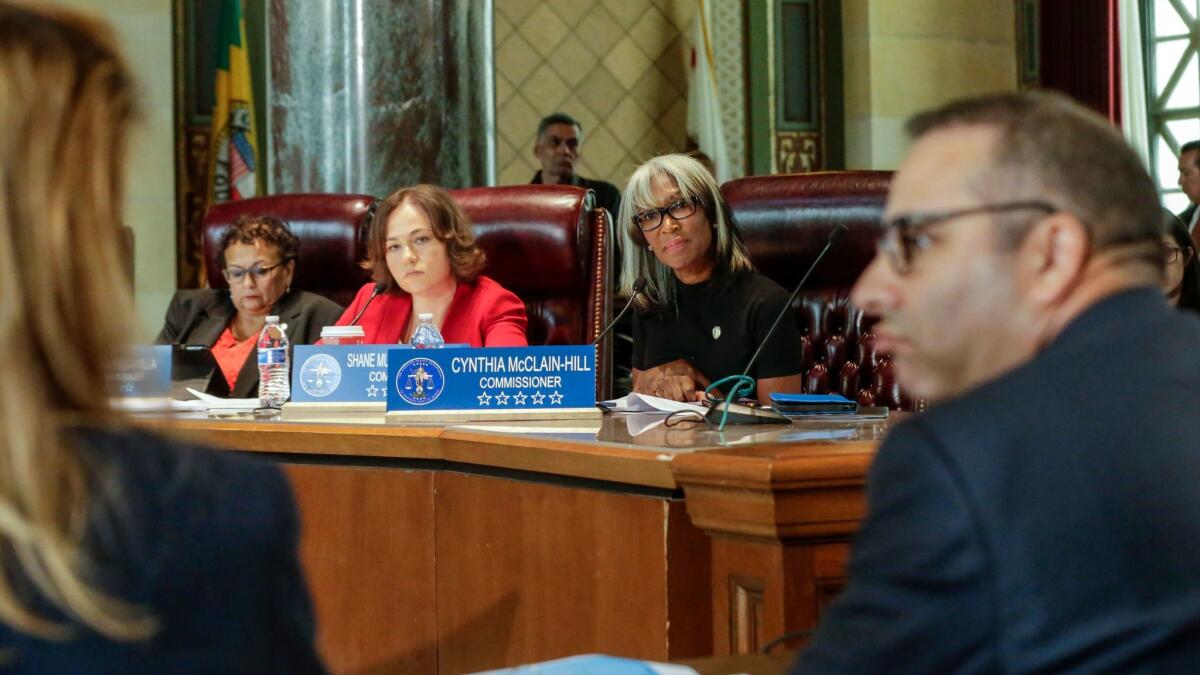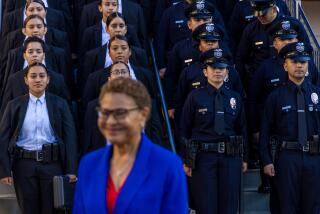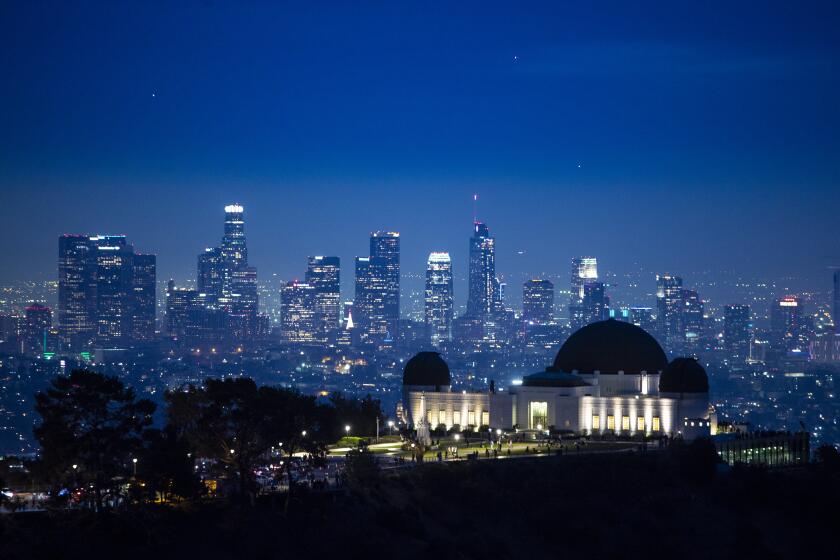L.A. police panel pushes fairness and courtesy as powerful weapons to improve trust in the LAPD

- Share via
They call it “procedural justice,” and the concept is pretty simple.
If people believe they are treated fairly and with respect by police, they are more likely to have a favorable view of law enforcement — even if their encounter ends with a ticket or an arrest. It’s a form of community relations that officials believe can help build goodwill and reduce mistrust.
For the record:
1:54 a.m. Feb. 27, 2025A previous version of this article said that Roy L. Austin Jr. worked on President Obama’s task force on 21st century policing. Although Austin worked closely with the presidential task force, he was not a member of the task force itself.
It can be as simple as officers handing out their business cards or spending a few extra minutes explaining why they pulled someone over.
Los Angeles police officers have been told in the past to do some of these things, but a new report found that this kind of behavior has still not been completely embraced by everyone in the LAPD.
So the Los Angeles Police Commission this week adopted a wide-ranging set of changes that called on the department to deepen procedural justice practices.
The directives are part of the civilian panel’s broader push to further reform the LAPD, which has included significant adjustments to how officers are trained and when they are allowed to use force. In voting for the latest changes, commissioners expanded their focus to other areas, including how the department guards against bias, shares data about policing with the public, and disciplines and deploys officers.
“We need to keep looking for ways to continue to make this department the best it can be,” said Matt Johnson, the panel’s president. “We need to continue engaging meaningfully with questions about community trust, race and use of force. I believe that these reports and recommendations provide a path forward to doing just that.”
The changes stemmed from a 49-page analysis by Inspector General Alex Bustamante, whose office compared the LAPD’s practices with two national reports that have drawn significant attention within policing: one from then-President Obama’s task force on 21st century policing and another from the Police Executive Research Forum, a Washington, D.C.-based think tank.
Police Chief Charlie Beck, a longtime member of PERF, noted that the LAPD has helped develop some of the national guidelines.
“The Los Angeles Police Department, I think, is a very reform-minded department. Do we always achieve that in practice? Well, no. Nobody’s perfect,” he told reporters. “But we certainly strive for it.”
Both PERF and the presidential task force have urged law enforcement to embrace the procedural justice philosophy. Bustamante’s report said putting the concept into practice can help officers gain someone’s cooperation during a tense encounter and reduce the likelihood of using force.
Steve Gordon, a director of the union that represents the LAPD’s rank-and-file officers, said he was glad the board required the LAPD to meet with the union when implementing the changes. Officers can bring important perspectives when figuring out how to adjust policing practices, he said.
“If anybody has an idea on how we as an organization can do police work better, we are all ears,” Gordon said. “We want to hear what these are, but we want to be at the table.”
Overall, Bustamante’s report gave the LAPD high marks, noting that the department had implemented many of the policing principles outlined by the two national studies. The presidential task force, for instance, cited the LAPD’s community policing efforts and civilian oversight as examples other agencies could draw upon. Beck testified before that panel in 2015 as it was crafting its recommendations.
But there were other areas where the LAPD could improve, Bustamante wrote.
The LAPD should resume publishing the data it collects on stops and arrests officers make, the report said, while also ensuring that the information is reviewed for potential evidence of bias or other mistreatment by officers. Although the LAPD has tried to analyze data about stops and searches in the past, Bustamante’s office said it was not aware of any process currently in place that allowed it to do so now.
To mitigate potential bias by officers, the LAPD last month launched department-wide training in March focused on “implicit bias” — subconscious bias people may not know they have.
In the wake of long-running complaints among officers that discipline is inconsistently doled out, the report said, the LAPD should conduct an in-depth evaluation to look for ways to improve officers’ faith in that process. Doing so, the report said, could expand the idea of procedural justice to how officers feel they are treated within the department.
“Discipline will never be popular,” the report added, but the department could do more to ensure officers feel they’ve been treated fairly and that the system is neutral.
The report also called on the LAPD to review its deployment strategies, which have been a hot-button issue among officers in recent months. The police union frequently complains that there are too few cops on the streets, forcing them to rush from call to call.
We need to keep looking for ways to continue to make this department the best it can be.
— Matt Johnson, president of the Los Angeles Police Commission
The report cited concerns from officers that the emphasis by department brass on “producing results” — such as making arrests or taking guns off the streets — deters officers from spending time interacting with residents. The report recommended that the LAPD find ways to better measure and promote “activities associated with community policing.” The inspector general called for the deployment review to examine whether officers had enough time to stop to talk with residents and build relationships.
One of the most significant changes came in the recommendation that officers, when it is safe to do so, provide basic aid to someone they might have used force against, including people shot by police. The LAPD has drawn criticism over some police shootings in recent years, after video showed some officers standing near the person shot, waiting for paramedics to arrive.
The commission unanimously adopted the recommendations, directing the department to make the changes.
Roy L. Austin Jr., a D.C.-based attorney and former Obama administration official who worked closely with the policing task force, said the inspector general’s report provided a “thoughtful and comprehensive” review of the LAPD’s practices. Austin said that after the task force made its recommendations, he had hoped agencies would conduct evaluations such as this.
The report “gives LAPD credit for where it’s getting it right and specifically notes places where LAPD could do better,” he said. “There is not a law enforcement agency in the country that could not benefit from going through this process.”
ALSO
As thousands marched, here’s how the LAPD handled May Day
Fewer shootings by police — that’s the goal of new rules adopted by the L.A. Police Commission
UPDATES:
3:40 p.m.: This article was updated with additional details about procedural justice.
This article was originally published at 7:40 p.m. on May 2.
More to Read
Sign up for Essential California
The most important California stories and recommendations in your inbox every morning.
You may occasionally receive promotional content from the Los Angeles Times.











